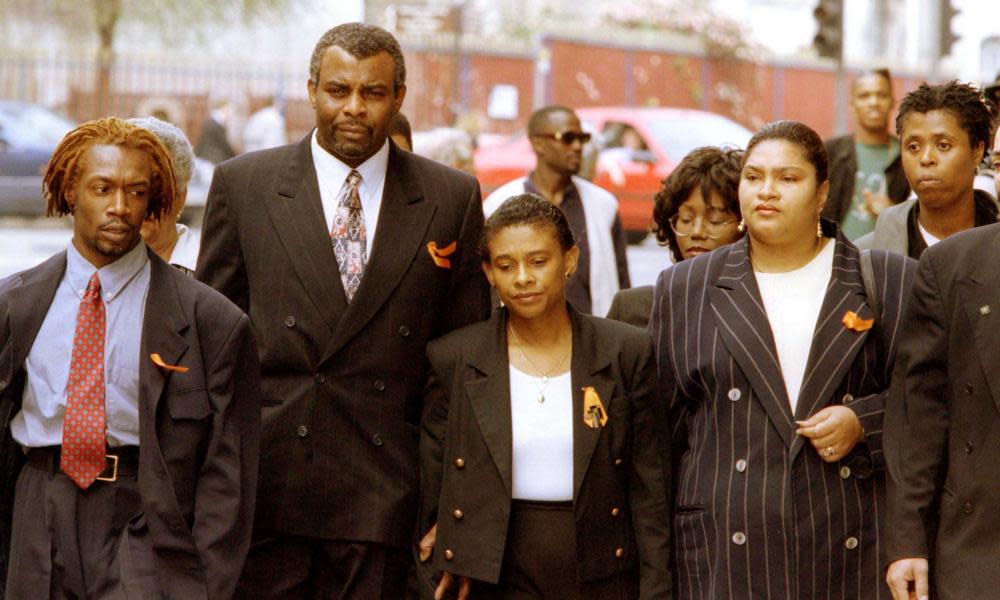Met closure of Stephen Lawrence case will deny his family justice

Convicting all of the suspects in the racist gang of five or six people that killed Stephen Lawrence would have delivered justice for his family, and some measure of redemption for the Metropolitan police. Scotland Yard’s decision to close the case means neither will get what they longed for.
For Doreen and Neville Lawrence the loss of their first child, Stephen, was a personal catastrophe that over the years turned into a symbolic case for the nation, and remains so.
He was the talented schoolboy from a household where hard work, education and faith in God were the guiding stars, whose life ended aged 18 at the hands of a gang of racist thugs.
Related: Stephen Lawrence: a timeline of events since the teenager's murder
His parents expected the world-renowned Met to hunt the killers down. Instead they were failed because of the colour of their skin, a subsequent public inquiry by Sir William Macpherson would find.
The Met did not arrest anyone in the vital first two weeks following the murder, only doing so when Nelson Mandela shamed them by highlighting the their inaction.
Over the years the significance of the case and its lessons have grown. From Britain’s black communities, for whom it was a reminder of unequal treatment before the law, to others who were forced to confront racial injustices that blight lives.
For the Met’s leadership, convinced it has turned the corner on race, the decision announced on Tuesday to cease an active inquiry into the remaining prime suspects after 27 years is a commonsense conclusion when all lines of inquiry have resulted in a dead end.
For others, including Neville Lawrence, it will be another sign of the Met giving up, after a long line of failures and questionable decisions. In their hearts the Lawrences believe catching all of Stephen’s killers is a matter of will and that the Met has lacked that across the decades.
The one exception since their son was killed in 1993 was a detective whose determination they were convinced of, and who was the one who secured the only murder convictions.
DCI Clive Driscoll’s reinvestigation of every aspect of the case led to the forensic breakthrough that led to David Norris and Gary Dobson being found guilty of Lawrence’s murder in January 2012. But even in the glow of that victory, it was made clear to the Met that there was much more to do.
Shortly after the pair’s sentencing, the trial judge made an unusual move.
In a packed Old Bailey court room, Mr Justice Treacy asked Driscoll to enter the witness box. Usually trial judges lavish nothing but praise on the police after such high-profile convictions, but the judge urged the Met to find the rest of the gang: “The convictions of Gary Dobson and David Norris will not hopefully close the file on this matter. On the evidence before the court, there are still three or four other killers of Stephen Lawrence at large.
“Just as advances in science have brought two people to justice, I hope the Metropolitan police will be alert to future lines of inquiry not only based on advances in science but perhaps also from information from those who have been silent so far, whoever they might be.”
For the Met, Driscoll should have been a hero. By 2014, he was gone. He said he was asked to retire when he was desperate to stay on and optimistic about a new lead.
For British policing, the decision about the Lawrence case comes at a time when its modern day record is being fiercely questioned.
From alleged targeting and handcuffing of innocent black people for stop and search, to claims of enduring prejudice facing ethnic minority officers, claims of racial injustice still haunt policing.
Almost three decades on from the Lawrence case, the official figures show that black people are more likely to have force used against them by the police – they are eight times more likely to have Tasers used on them, and nine times more likely to be stopped and searched.
The Black Lives Matter protests in which more than 250,000 people took to Britain’s streets to protest, showed concerns about racial justice are still very much alive, with new symbols being found to go with the old ones.

 Yahoo News
Yahoo News 
